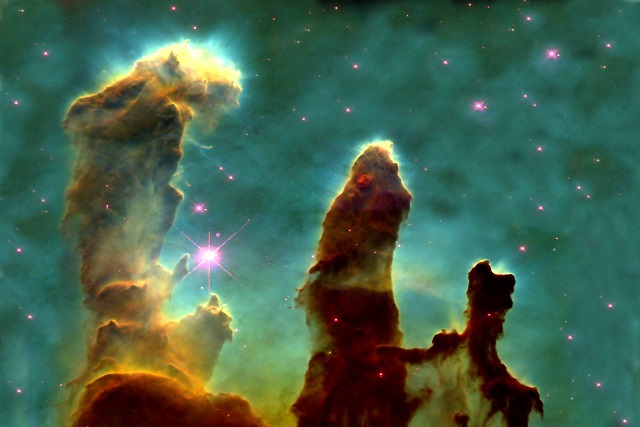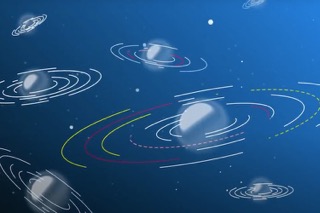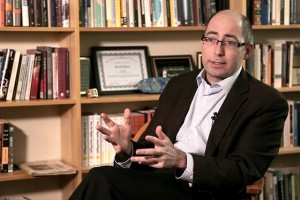American Physics in the Cold War
Physicist David Kaiser on the US education funding course, the impact of politics on physics, and connections ...

In September Nature published an article called ‘Dense cloud cores revealed by CO in the low metallicity dwarf galaxy WLM’. We asked one of the authors, Dr Bruce Elmegreen from IBM T.J. Watson Research Center, to comment on this study.
The dense cores of star-forming clouds have been observed for the first time in a tiny dwarf galaxy.
The observation was made by the Atacama Large Millimeter/submillimeter Array telescope on the Chajnantor Plateau in northern Chile using emission from Carbon Monoxide molecules in the cloud.
Emission like this has been very difficult to detect because dwarf galaxies have a low abundance of carbon and oxygen compared to larger galaxies like the Milky Way, so the CO molecule is rare. The detection is important because it tells us something about how stars form, and these dwarfs are important because they are probably the formation sites of the very old globular clusters that orbit in the halo of the Milky Way.

Source: Rubio, et al. 2015, Nature, Vol 525, p. 218. (Fig.1)

Molecular clouds are the densest and coldest phase of the gas that lies between stars in galaxies. Gravity inside the clouds eventually overcomes pressure and magnetic forces to cause pieces of the cloud to collapse into individual and binary stars and their swirling proto-planetary disks. The molecules are important for this process because they help cool the gas to 10 or 20 degrees above absolute zero, and this cooling removes most of the pressure support. Also important are tiny particles of dust, less than a micron in size, because they block out the heat from surrounding starlight, and this also promotes cooling. Stars form in about the same conditions everywhere in the universe, in cool and dense gas where self-gravity can dominate all other forces.
The first observations of molecular clouds came in 1970 with the discovery of emission from interstellar carbon monoxide near the Orion Nebula at a spectral line frequency of 115 GHz, which corresponds to a wavelength for light of 2.6 millimeters. This discovery was made by Robert Wilson and Arno Penzias, who later got the Nobel Prize for their discovery of microwave emission from the Big Bang, along with Keith Jefferts, all of Bell Laboratories in the Unites States. Carbon monoxide turned out to be easily detected throughout the solar neighborhood and inner regions of the Milky Way as it is a tightly bound molecule composed of relatively abundant atoms, Carbon and Oxygen, and it also radiates away its rotational energy rather quickly, being asymmetrical in structure. A far more abundant molecule in these dense cold regions is molecular Hydrogen, H2, but that does not radiate nearly as well as CO because it is too symmetric. Thus CO is the primary tracer of the clouds where stars form.
Now we see there can be a problem for galaxies with very little Carbon and Oxygen in their gas. This is the case for tiny galaxies which cannot hold on to the metal-rich debris that comes from supernovae and which never had much star formation and supernovae in the first place considering their low stellar masses and large reservoirs of gas remaining. All elements in the Periodic Table heavier than Hydrogen, Helium and Lithium, formed in stars through a diverse sequence of processes, all involving nuclear burning or nuclear bombardment of heavy nuclei by smaller nuclei. Some of the Helium in the universe also formed this way. Carbon and Oxygen tend to form by slow nuclear burning during the late stages in the lives of massive stars, Carbon by the successive attachment of 3 Helium nuclei and Oxygen by the attachment of another He nucleus to a Carbon. These elements are then dispersed into the surrounding space when that star explodes as a supernova. This dispersal can be so powerful that small galaxies cannot hold on to it with their weak gravity, so they lose the Carbon and Oxygen that their own stars produce. In this case, they cannot easily form CO, and we cannot easily detect and measure the gas in their star-forming regions.
Carbon Monoxide was originally sought in tiny galaxies in 1980 by my colleagues Debra Elmegreen, Mark Morris, and myself, with null results. We published that in the Astrophysical Journal and speculated on possible reasons for the difference from the Milky Way. As mm-wavelength telescopes got better and better, others kept looking for it but it was still never seen. Only in one of our nearest small neighbors, the Small Magellanic Cloud, was it found, but that galaxy is not particular depleted in C and O, it is depleted compared the solar abundance by only a factor of 5. That is enough to make CO difficult to find, but not impossible. One of my colleagues in our most recent work, Monica Rubio, discovered CO in the Small Magellanic Cloud in 1986 using a telescope in Chile run by Patrick Thaddeus, a Professor at Columbia University in New York City. The Small Magellanic Cloud has been mapped completely now and much is understood about star formation in it because of the observed molecular clouds.
There is still a need to observe star-forming regions at lower metallicities, however. One important reason is that the globular star clusters orbiting us in the halo of the Milky Way have heavy element abundances less than one-tenth solar, and we would like to understand how they formed. These clusters are very old, nearly as old as the universe, and many of them probably formed in small galaxies which had low metal abundances even then. These small galaxies have since gotten captured by the Milky Way and all that is clearly visible from them are the massive clusters they formed. We might eventually observe similar small galaxies forming globular clusters like this at high redshift where all of the galaxies and the universe itself appear as they were when they were very young. This glimpse into the past is possible because it took a long time for the light from these galaxies to reach us, so we are seeing them now as they looked in the distant past. Their star formation almost certainly took place in molecular clouds with very low Carbon and Oxygen abundances. How do we eventually see these clouds if CO is weak? What can we infer about the star formation processes then if we don’t know what CO looks like even in local galaxies where CO is weak? We expect the structure of molecular clouds at low metallicity to be different but we don’t know all the consequences of this difference.
With this motivation in mind, we formed a team to search for CO in a representative nearby tiny galaxy, WLM (which stands for Wolf-Lundmark-Melotte after Max Wolf, who first discovered it in 1909, and Knut Lundmark and Philibert Jacques Melotte who discovered it again in 1926). The abundance of Oxygen in WLM is 1/8 solar, significantly lower than in the Small Magellanic Cloud and a reasonable step towards observing molecular clouds with 1/10 or lower solar abundance. Over a period of two years, we observed two regions of this galaxy using the telescope APEX for a total of 7.8 hours in the spectral window where CO should appear. APEX stands for Atacama Pathfinder EXperiment, and it is at Llano de Chajnantor, Chile. We eventually found it in both regions. By observing the emission from cold dust seen with the Spitzer infrared satellite and from our own observations of dust emission in WLM with the APEX telescope, we could determine how much gas in all forms was likely to be there, and by subtracting the known amount of atomic hydrogen from our observations using the Jansky Very Large Array in Socorro New Mexico, we could indirectly measure the mass of molecules. That is, all the gas that cannot be seen in atomic form is assumed to be molecular. This molecular mass, compared with the observed CO, indicated even then that CO was a very small component of molecular clouds in WLM. This is what we were expecting, but it was finally good to see. The team members on that publication, in addition to Monica Rubio from the University of Chile in Santiago, were Deidre Hunter from Lowell Observatory, Elias Brinks from the University of Hertfordshire, Celia Verdugo, one of Monica’s PhD students in Santiago, and Andreas Shruba of the California Institute of Technology.
The final step in this long search came with the ALMA telescope on the Chajnantor Plateau in northern Chile. ALMA stands for the Atacama Large Millimeter/submillimeter Array and is run by the European Southern Observatory, the National Radio Astronomy Observatory of the Associated Universities Inc., and the National Astronomical Observatory of Japan. With ALMA, which is an interferometer, we could use many telescopes at the same time and map the CO emission to high sensitivity with 1 arcsec resolution, corresponding to 15 light years at the galaxy’s distance of about 3 million lightyears. We found and resolved 10 very small CO clouds in the centers of the molecular regions detected by APEX. We were finally seeing the cold and dense cores where stars form in this galaxy. Our collaborators included some from the first team, Monica Rubio, Deidre Hunter, and Elias Brinks, along with Juan Cortés from the Joint ALMA Observatory and National Radio Astronomy Observatory, and Phil Cigan, a PhD student at the New Mexico Institute of Mining and Technology.
The properties of these cores were pretty surprising to us: they looked the same as any other low mass molecular clouds, even those right next to us in the Milky Way. They had about the same densities, pressures, opacities to starlight, and internal turbulent speeds as the local clouds, even though WLM was generally extremely fluffy and low pressure on average. We could see, however, that the molecular core conditions were set by the enormous pressures of the overlying molecular and atomic layers, which bear down on the tiny CO cores and make them dense. This was really the most interesting discovery to us, that after years of work to catch a glimpse of what we thought was going to be something extraordinarily different, it ended up being perfectly familiar. Perhaps the conditions needed to make CO molecules are the same everywhere, and in extraordinary environments these conditions are rare. But when they occur, we get normal clouds.
Now that we know what to look for, there is a lot more to do. We would like to map the rest of WLM to see how CO varies inside and outside of the most intense star-forming regions. We also have a long list of other galaxies with low carbon and oxygen abundances, including some at less than 1/10 solar. Eventually we will see the conditions where the old globular clusters formed and then we will know what we are looking for in the high redshift universe.

Physicist David Kaiser on the US education funding course, the impact of politics on physics, and connections ...
Physicist Eric Mazur on semiconductor surfaces, light detection, and the conversion of solar energy into elect...

Joanna D. Haigh on the 'little ice age', solar radiation, and global warming